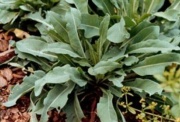Difference between revisions of "Woad"
m (Text replace - "\[http:\/\/cameo\.mfa\.org\/materials\/fullrecord\.asp\?name=([^\s]+)\s(.*)\]" to "$2") |
|||
| Line 1: | Line 1: | ||
| − | [[File:isatis.jpg|thumb|Woad plant | + | [[File:isatis.jpg|thumb|Woad plant''Isatis tinctoria L.'']] |
| − | |||
| − | ''Isatis tinctoria L.'']] | ||
== Description == | == Description == | ||
A natural dark blue dye obtained from the biennial ''Isatis tinctoria'' plants. Woad was cultivated since early times as a textile dye in England, France, Greece, Italy, Egypt, and China. In western Europe, woad was the only blue dye used until the introduction of [[indigo|indigo]] in the early 17th century. For production, the plant leaves were cut, dried and rolled into balls (woad balls) to age for about one month. Then the balls were crushed to a fine powder, sprinkled with water and piled in heaps for fermentation. The blue color deepened with the age of the plant ranging from a light blue in young leaves to a dark bluish black in fully ripe leaves. The colorant in woad is chemically similar to indigo. | A natural dark blue dye obtained from the biennial ''Isatis tinctoria'' plants. Woad was cultivated since early times as a textile dye in England, France, Greece, Italy, Egypt, and China. In western Europe, woad was the only blue dye used until the introduction of [[indigo|indigo]] in the early 17th century. For production, the plant leaves were cut, dried and rolled into balls (woad balls) to age for about one month. Then the balls were crushed to a fine powder, sprinkled with water and piled in heaps for fermentation. The blue color deepened with the age of the plant ranging from a light blue in young leaves to a dark bluish black in fully ripe leaves. The colorant in woad is chemically similar to indigo. | ||
| − | + | [[File:Uemura 08-13-2009 274.jpgthumb|Silk dyed with woad; Uemera Dye Archive]] | |
| + | * See also [[http://cameo.mfa.org/wiki/Category:Uemura_dye_archive '''Uemera Dye Archive''' (Taisei)]] | ||
== Synonyms and Related Terms == | == Synonyms and Related Terms == | ||
dyer's woad (''Isatis tinctoria''); Waid (Deut.); Färberwaid (Deut.); Deutscher Indigo (Deut.); guède (Fr.); glasto (Esp.); guado (It.); issatis bafiki (Gr.); wede (Ned.); índigo (Port.); glastum; weit; waisdo; wod; anthrax; pastel; English indigo; blue balls; woad balls | dyer's woad (''Isatis tinctoria''); Waid (Deut.); Färberwaid (Deut.); Deutscher Indigo (Deut.); guède (Fr.); glasto (Esp.); guado (It.); issatis bafiki (Gr.); wede (Ned.); índigo (Port.); glastum; weit; waisdo; wod; anthrax; pastel; English indigo; blue balls; woad balls | ||
| − | == | + | == Resources and Citations == |
| − | |||
| − | |||
| − | + | * H.Schweppe, "Indigo and Woad", ''Artists Pigments'', Volume 3, E. West FitzHugh (ed.), Oxford University Press: Oxford, 1997 | |
* R. J. Gettens, G.L. Stout, ''Painting Materials, A Short Encyclopaedia'', Dover Publications, New York, 1966 | * R. J. Gettens, G.L. Stout, ''Painting Materials, A Short Encyclopaedia'', Dover Publications, New York, 1966 | ||
Revision as of 15:25, 30 June 2020
Description
A natural dark blue dye obtained from the biennial Isatis tinctoria plants. Woad was cultivated since early times as a textile dye in England, France, Greece, Italy, Egypt, and China. In western Europe, woad was the only blue dye used until the introduction of Indigo in the early 17th century. For production, the plant leaves were cut, dried and rolled into balls (woad balls) to age for about one month. Then the balls were crushed to a fine powder, sprinkled with water and piled in heaps for fermentation. The blue color deepened with the age of the plant ranging from a light blue in young leaves to a dark bluish black in fully ripe leaves. The colorant in woad is chemically similar to indigo. Silk dyed with woad; Uemera Dye Archive
- See also [Uemera Dye Archive (Taisei)]
Synonyms and Related Terms
dyer's woad (Isatis tinctoria); Waid (Deut.); Färberwaid (Deut.); Deutscher Indigo (Deut.); guède (Fr.); glasto (Esp.); guado (It.); issatis bafiki (Gr.); wede (Ned.); índigo (Port.); glastum; weit; waisdo; wod; anthrax; pastel; English indigo; blue balls; woad balls
Resources and Citations
- H.Schweppe, "Indigo and Woad", Artists Pigments, Volume 3, E. West FitzHugh (ed.), Oxford University Press: Oxford, 1997
- R. J. Gettens, G.L. Stout, Painting Materials, A Short Encyclopaedia, Dover Publications, New York, 1966
- R.J. Adrosko, Natural Dyes in the United States, Smithsonian Institution Press, Washington, DC, 1968
- R.D. Harley, Artists' Pigments c. 1600-1835, Butterworth Scientific, London, 1982
- R. Newman, E. Farrell, 'House Paint Pigments', Paint in America , R. Moss ed., Preservation Press, New York City, 1994
- Thomas B. Brill, Light Its Interaction with Art and Antiquities, Plenum Press, New York City, 1980
- F. Crace-Calvert, Dyeing and Calico Printing, Palmer & Howe, London, 1876
- G.S.Brady, Materials Handbook, McGraw-Hill Book Co., New York, 1971 Comment: p.284
- Ralph Mayer, A Dictionary of Art Terms and Techniques, Harper and Row Publishers, New York, 1969 (also 1945 printing)
- Susan E. Schur, Conservation Terminology: A review of Past & Current Nomenclature of Materials, Technology and Conservation, Spring (p.34-39); Summer (p.35-38); Fall (p.25-36), 1985
- Art and Architecture Thesaurus Online, http://www.getty.edu/research/tools/vocabulary/aat/, J. Paul Getty Trust, Los Angeles, 2000
